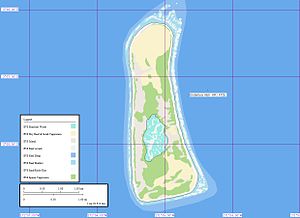Enderbury
| Enderbury | ||
|---|---|---|
| NASA image of the Enderbury Atoll | ||
| Waters | Pacific Ocean | |
| Archipelago | Phoenix Islands | |
| Geographical location | 3 ° 8 ′ 0 ″ S , 171 ° 5 ′ 0 ″ W | |
|
|
||
| length | 4.8 km | |
| width | 1.5 km | |
| surface | 5 km² | |
| Residents | uninhabited | |
| Map of Enderbury | ||
Enderbury ( English Enderbury Island ) is a small, uninhabited upscale atoll in the Pacific Ocean ; it is about 68 km southeast of Canton , the largest atoll of the Phoenix Islands . Politically, the island belongs to the Pacific island republic of Kiribati .
Enderbury is almost 3 kilometers wide and up to 8.8 kilometers long and is surrounded by a coral reef that runs close to the coast . The atoll has the very small remainder of a lagoon , the land area takes up most of this atoll.
history
The atoll was discovered in 1823 by Captain James J. Coffin from the British whaling ship Transit . The name " Enderbury " goes back to a corrupted version of "Enderby" (after the shipowner Samuel Enderby (1756-1829), the owner of a London whaling company).
In 1860, the USA took possession of the atoll in order to mine guano on a massive scale - as on most of the Phoenix Islands . Mining peaked in 1870 under the leadership of the American Phoenix Guano Company , when 6000 tons of guano were mined and exported in just 64 days. After the Americans had exploited almost all of the guano deposits and left Enderbury in 1877 , the area was briefly taken over by a British guano company, although the mining was hardly profitable.
In 1939 the United States and Great Britain agreed to jointly control the atoll for 50 years.
The buildings and other facilities that had been built for the guano workers on the island were destroyed by the Americans themselves during World War II to prevent them from being used by the Japanese .
Like all atolls on the Phoenix Islands, Enderbury has been part of the island republic of Kiribati since 1979 .
Flora and fauna
The island's flora consists only of low grasses and a few bushes, where only numerous species of seabirds nest and rest , each in large numbers.
- gallery
A masked booby in its nest
See also
- Guano Islands Act , US law (1856), which legitimized the mining of guano by the USA
literature
- Edwin H. Bryan, Jr .: American Polynesia. Coral islands of the Central Pacific . Tongg publishing company, Honolulu HI 1941, (Reprinted from Honolulu Advertiser September 11, 1939 to July 15, 1940).
- Jimmy M. Skaggs: The great guano rush. Entrepreneurs and American overseas expansion . St. Martin's Press, New York NY 1994, ISBN 0-312-10316-6 .
Web links
- Maps, pictures and information about Enderbury ( Memento from August 25, 2013 in the Internet Archive )
- Historical maps, pictures and information (English)






